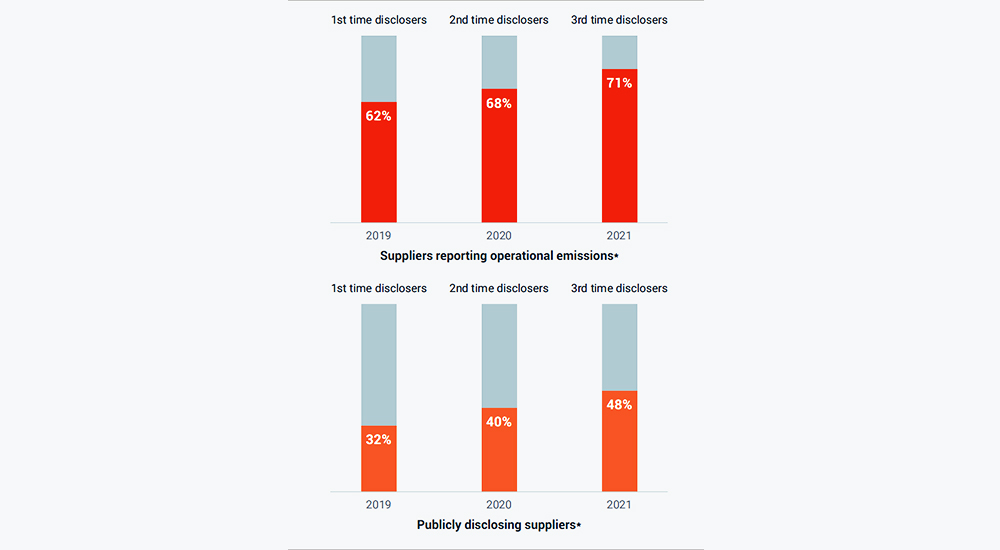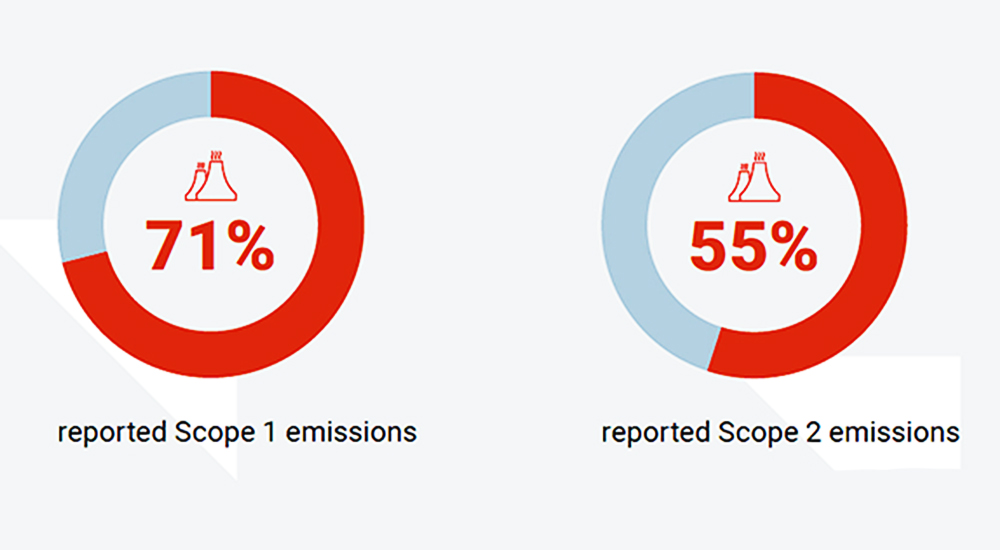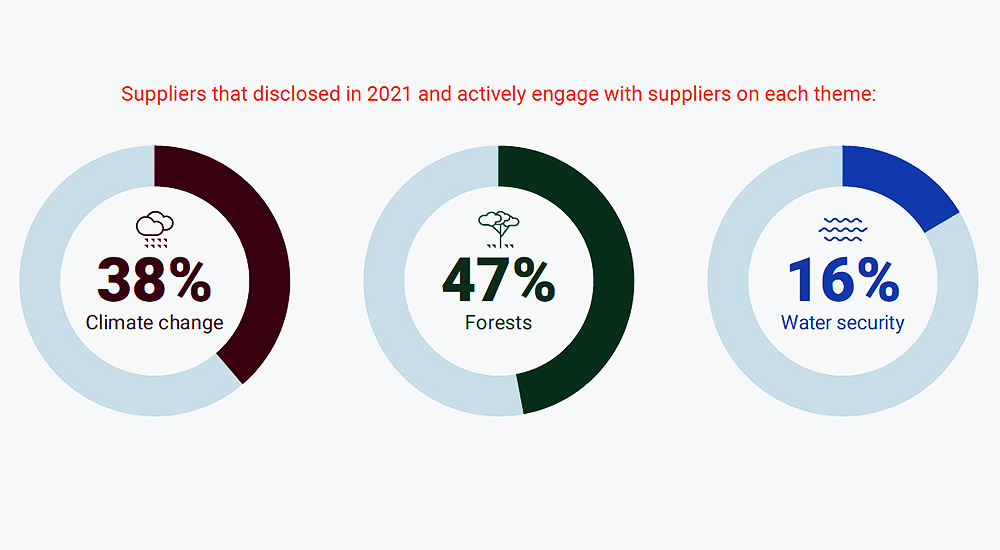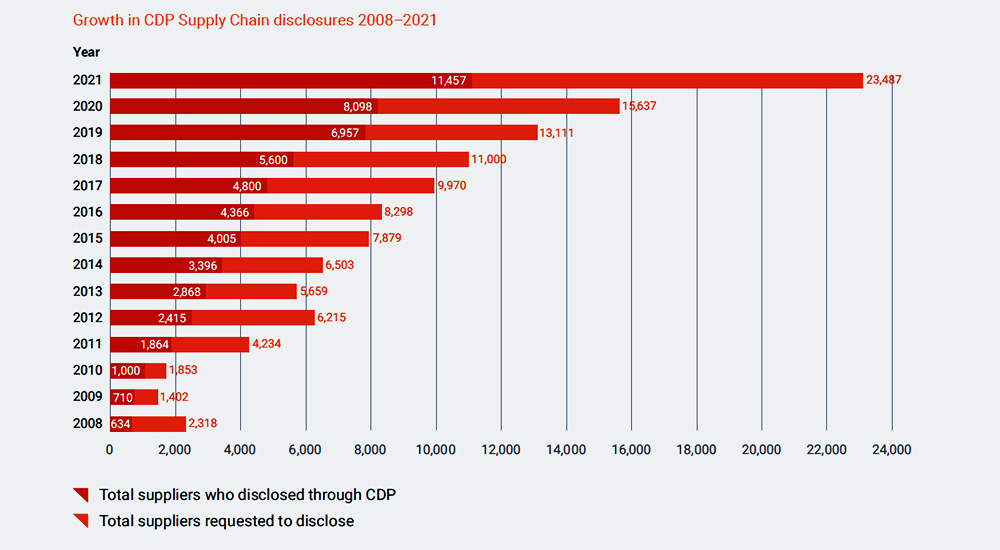A company’s supply chain is responsible for substantial environmental impacts. Last year, CDP found that greenhouse gas emissions in a company’s supply chain are, on average, 11.4 times higher than operational emissions.
This chain of environmental risk is not just an opportunity to look beyond companies’ own emissions and cascade their ambition; it is now the only way to leverage change at the scale required.
The CDP, formerly known as the Carbon Disclosure Project, is an international non-profit organisation that helps companies and cities disclose their environmental impact. It aims to make environmental reporting and risk management a business norm, driving disclosure, insight, towards a sustainable economy.
However, suppliers must think beyond climate change alone. Harm to the environment encompasses deforestation and water scarcity, but this realisation is not reflected in the reported data across themes.
Many suppliers that operate in water-stressed areas, or source forest commodities in high-risk regions, are unable to report any data on their water withdrawals or volumes of production and consumption of forest commodities. As emphasized at COP26, The 2021 United Nations Climate Change Conference, stand-alone actions are not sufficient. Environmental issues are interconnected; companies cannot meet their climate net-zero targets whilst generating mass deforestation in their supply chain.
High-performing companies in this area ask suppliers to report data and set targets to reduce their Scope 3 emissions.
Ambitious environmental action is not yet cascading down the supply chain. Alongside insufficient tracking, CDP data also demonstrates a lack of engagement with suppliers. For example, on Climate Change, only 20% reported data for Scope 3 category 1, Purchased Goods and Services’ emissions, and 62% are not engaging suppliers on the topic.
Put simply, companies are not making the necessary transformational changes to truly drive action at the required scale. A continuously increasing number of organisations set environmental targets. However, they are often not aligned with climate science and 1.5°C reduction pathways. Less than 5% of suppliers reported that they put in motion climate transition plans.
However, there is hope. CDP data demonstrates that engaging suppliers on the environment does drive change. This year’s data shows that consistent engagement from purchasers creates momentum in key areas. For instance, leveraging influence from the top downwards speeds up the rate of change.
Measurement is the entry point for most buyers that engage with suppliers to understand and quantify their environmental impact. The environmental information reported through CDP is used by CDP Supply Chain members and their suppliers to track their value chain performance year-over-year and drive action.
This increase in responses is linked to companies facing growing pressure for more environmental transparency from their customers and other stakeholders. Increased awareness and accountability, demonstrated through more granular quantitative data and verification, will lay the foundation for meaningful change. What is not measured cannot be managed; data disclosure enables action.
SMEs offer enormous potential for change, providing 50% of the world’s employment and representing 90% of all businesses. It is therefore crucial that SMEs are equipped with the tools and resources needed to set goals aligned with a 1.5°C future and disclose environmental performance.
For this reason, CDP recently launched the SME Climate Disclosure Framework to empower small and medium-sized enterprises to make strategic and impactful climate commitments, track and report progress against those commitments, and demonstrate climate leadership. The framework provides key climate-related reporting indicators and metrics that




It is important to note that, at first request, suppliers may require a year or more to create the mechanisms required to collect data. When comparing first-time responders with those suppliers reporting through CDP for the third time, the percentage of suppliers disclosing operational Scope 1 and 2 emissions rises from 62% in the first year to 71%, third year.
Demonstrating increased confidence in their data, there is a growing number of suppliers opting to disclose their information publicly.
In 2021, 41% of responding suppliers agreed to have their climate change disclosure published on CDP’s website. 59% of suppliers kept their response private, which shows that many companies are still concerned with the accuracy of their disclosure in the face of public scrutiny.
Looking more closely at the suppliers that reported to CDP over three years, the percentage of those disclosing publicly rises consistently with time, from 32% to 48%, highlighting again that disclosure improves and grows confidence over time.
As in financial reporting, data accuracy and verification must be built into the process, to ensure the quality of the disclosed information. Among the suppliers responding on climate change, only 17% verify their operational emission data through third-party verification; among the suppliers that disclose on water security, 12% externally verify the data reported through CDP, and 31% of suppliers reporting on forests verified the disclosed information.
CDP analysis reveals that it takes time to perform a truly comprehensive and verified environmental impact assessment. Buyers are highly reliant on this information to understand their own supply chain impacts as such engagement on this data, and improving it, is the first step for buyers in tackling their supply chain impacts.
85% of surveyed members in 2021 engage with their suppliers on expanding the scope and the quality of the data reported, 46% of whom have been doing so for over three years. Members engage with their suppliers on a constant basis, and work with them to build capacity for environmental impact assessment and reporting.
While environmental KPIs are being integrated into supplier code of conducts and criteria used for the purchasing and supplier evaluation processes, members increasingly look at their suppliers’ data as part of their own environmental performance, for example when setting science-based targets.
Once suppliers have successfully established their impact through accurate measurement, they are equipped to set ambitious, timebound goals to reduce this impact.
As the climate crisis continues to rapidly unfold all over the world, it is evident that target setting must happen at a larger and faster scale than ever before. At the same time, it is important to design these targets in such a way that they are compliant with the time-critical criteria set out in the Paris Agreement.
An annual 5% growth rate would be too slow to meet the standards set out in the Paris Agreement. Supply Chain data shows that practicing environmental stewardship by cascading targets and progressive policies down the value chain must be the next step.
CDP data demonstrates the time lag between suppliers assessing their environmental impact and setting emissions reduction targets. CDP recently analysed suppliers who began disclosing in 2019 and consistently reported their climate impact over the past three years. The absolute number of those setting climate targets improved on average 5% per year.
Setting any target is a critical first step. However, the science is clear; we are too close to the deadline for averting dangerous climate change unless the right goals and targets are set. Structured climate targets, that currently make up a third of reported targets, only mark the beginning of the climate target journey. The most ambitious targets are based in science and align with a 1.5°C future.
Through CDP’s platform, in 2021, only 28% of suppliers disclosed that they have a low-carbon transition plan in place. This number is too low, and one that is expected to drop further with assessment of these transition plans against stakeholder expectations.
For example, do they have science-based targets? Are there sufficient accountability mechanisms in place to ensure delivery and are they effectively tracked in a manner that allows stakeholders to assess progress?
Taking a deeper look at the data provided by suppliers, we often find that strategies do not match stakeholder expectations. Only 2.5% of these targets are approved science-based targets that are aligned with emissions reductions needed to stay below 1.5°C.
Financial institutions and investors are increasingly focusing on how companies manage their environmental risks and opportunities. Accordingly, companies that manage to grasp and realise environmental opportunities will harvest the benefits of investment– in addition to the market benefits.
A related feature required to transform environmental concerns in supply chains is board-level oversight. To truly avert catastrophic climate change and ensure a deforestation-free, water-secure future, companies need to undergo a transformation in the way they work.
Taking into consideration that more than half of the suppliers did not have any climate target in the 2021 reporting year, this finding implies that, at the current pace, at least another decade would be required to ensure that all reporting suppliers set a climate target.
Unless companies pivot to a new paradigm where governance and strategy are improved, they are going to fail to realise opportunities. With companies reporting $338 Billion associated opportunities related to climate.
Results of the CDP, BCG 2021 report
The CDP, BCG report explores the environmental impact that supply chains have, and actions buyers are taking to reduce them. The CDP Supply Chain programme, representing over 200 member organisations with $5.5 trillion in annual procurement spend, requested that suppliers report to members on their current and future risks and opportunities related to these environmental issues.
Suppliers responded to standardised questionnaires on climate change, forests and water security: a full version and a simplified version made available for organisations with an annual turnover of less than $250 Million or €250 Million, which can also be used by larger organisations disclosing for the first time. In total 23,487 companies were invited to participate, with over 11,457 unique responses received.
In 2021, despite the continual economic disruption of Covid-19, CDP received a record number of environmental disclosures. This year’s results of CDP’s data submissions from over 11,457 companies shows moderate action on measuring and tackling environmental impacts resulting from direct operations. On climate change, 75% of suppliers reported on their Scope 1 and 2 emissions and took actions to reduce emissions resulting in 231 Million tonnes CO2e reduced.
There is a pattern of companies assessing their own operations and not looking at wider impacts. Despite downstream emissions being 11.4 times than Scope 1 and 2 emissions combined, only 20% of suppliers reported Scope 3 emissions from purchased goods and services.
Key takeaways
- Environmental issues are interconnected, companies cannot meet their climate net-zero targets whilst generating mass deforestation.
- Ambitious environmental action is not yet cascading down the supply chain.
- CDP data also demonstrates a lack of engagement with suppliers.
- Companies are not making necessary transformational changes to truly drive action at the required scale.
- A continuously increasing number of organisations set environmental targets not aligned with climate science and 1.5°C reduction pathways.
- Less than 5% suppliers reported that they put in motion climate transition plans.
- Measurement is the entry point for most buyers that engage with suppliers to understand and quantify their environmental impact.
- The environmental information reported through CDP is used by members and their suppliers to track value chain performance.
- What is not measured cannot be managed; data disclosure enables action.
- SMEs offer enormous potential for change, providing 50% of the world’s employment and representing 90% of all businesses.
- CDP recently launched the SME Climate Disclosure Framework to empower small and medium-sized enterprises to climate commitments.
- It is important to note that, at first request, suppliers may require a year or more to create the mechanisms required to collect data.
- Looking more closely at the suppliers that reported to CDP over three years, the percentage of those disclosing publicly rises consistently with time.
- Among the suppliers responding on climate change, only 17% verify their operational emission data through third-party verification.
- CDP analysis reveals that it takes time to perform a truly comprehensive and verified environmental impact assessment.
- As the climate crisis continues to rapidly unfold all over the world, it is evident that target setting must happen at a larger and faster scale than ever before.
- CDP data demonstrates the time lag between suppliers assessing their environmental impact and setting emissions reduction targets.
- At the current pace, at least another decade would be required to ensure that all reporting suppliers set a climate target.
- A related feature required to transform environmental concerns in supply chains is board-level oversight.
- To truly avert catastrophic climate change, companies need to undergo a transformation in the way they work.
The recent CDP and BCG global report into emission level disclosures inside an organisation’s supply chain indicates challenges ahead.




